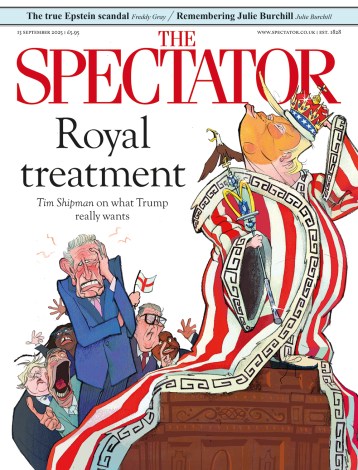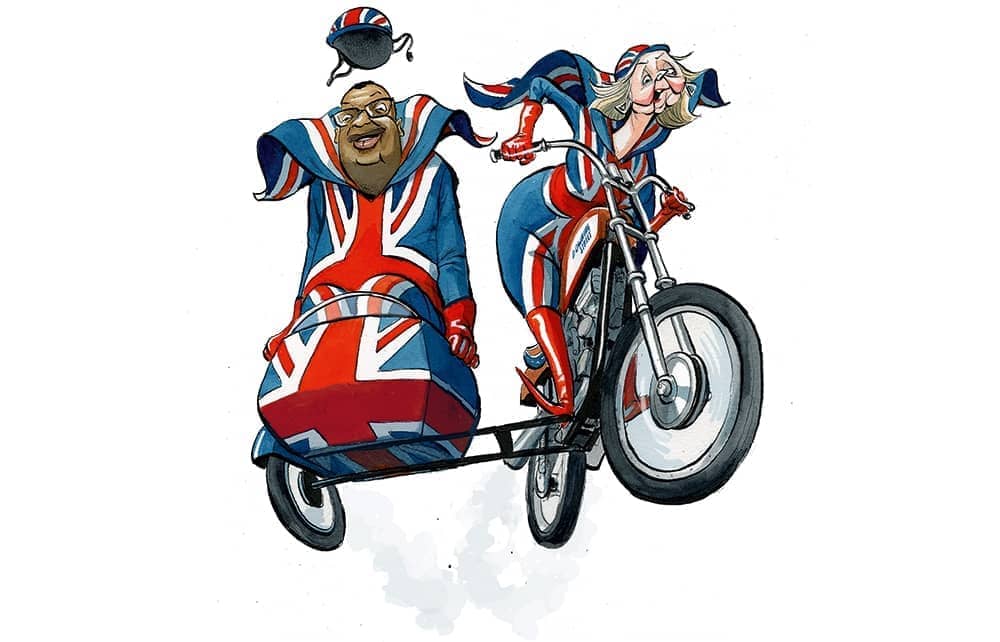Liz Truss and Kwasi Kwarteng arrive in Downing Street having been on a long political journey together. Both elected in 2010, they have co-written books setting out their shared economic agenda; they have co-founded party groups during their time in parliament; and now they will govern together. The future direction of the country, and the Tories’ electoral prospects, depend on the success of this new Downing Street partnership.
Their strategy is one of big economic gambles from day one. Chief among these is the big energy package, potentially costing over £100 billion, designed to ‘freeze’ energy prices for households and businesses. This will involve the state – future taxpayers, in other words – picking up the tab to protect today’s consumers from the current high prices. It’s an intervention on a par with furlough in both scale and cost, and will need to be financed with debt. It is bigger than anything the Blair or Cameron governments attempted. Truss’s tax cut – reversing the National Insurance rise – is tiny by comparison to the energy-bill bailout.
The energy freeze is a pragmatic move, not an ideological one – having politicians determine the price of energy is hardly free-market policy. But most governments in Europe, whether left or right, will be doing something similar, and they all hope debt markets will stump up the cash at an affordable rate. Truss’s hope is that a big bazooka approach to energy can give the government time and space to get going on the rest of its agenda.
The real start to her period in government will come later this month, with a budget (although it won’t be called that) reversing the National Insurance increase and cancelling the planned corporation tax rise (from 19 per cent to 25 per cent). This marks a substantial fiscal loosening. The idea is that this stimulus will head off a recession.
Perhaps more striking is what isn’t on the new Prime Minister’s priority list: spending cuts. A number of Tories dared to hope that with Boris Johnson gone, the profligacy of the last few years would cease – yet Truss and Kwarteng seem happy to fund hugely expensive measures through borrowing. It’s a dramatic shift from Truss’s earlier political career: in 2009 she was writing pamphlets about what could be cut in the aftermath of the financial crash, while Kwarteng would suggest throughout the Cameron and Osborne years that the Tories were too slow in reducing the deficit. Now, the hope is that the economic growth stimulated by tax cuts and reform will make massive government spending affordable.
To understand the scale of the gamble, consider the latest Bank of England forecasts. The Bank envisages the UK economy flatlining for years, with no growth to speak of. To Truss, this reflects the burden of high taxes – the highest since the 1950s. But state spending is now so big (and about to get bigger with the energy-bill bailouts) that making a meaningful difference is hard. When Truss and Kwarteng first entered parliament, few would have expected them to be dramatically intervening in the energy markets and borrowing huge sums to boost growth.
Truss and Kwarteng seem happy to fund hugely expensive measures through borrowing
Yet their shift towards being more relaxed about debt represents a wider move in thinking on the economy within the Tory party. There is a general frustration about the rising tax burden and a growing feeling that this trajectory must change immediately, regardless of circumstance. Kwarteng has been known to warn that if things stay the same, then Britain will end up with a ‘neo-Butskellite consensus’ on economic management.
The Truss-Kwarteng solution is to move away from traditional fiscal conservatism: to cut taxes, borrow more and reform the economy, hoping that growth will pay for the borrowing. Thatcher’s allusions to household finances are out, replaced by confident assertions that the markets are more forgiving nowadays and the British state has the flexibility to borrow what it wants, and at low rates.
James Carville, Bill Clinton’s political point man, once joked that he wanted to be reincarnated as the bond market because ‘you can intimidate everybody’. But during both the financial crash and Covid, developed economies managed to borrow unprecedented sums of money without seeing their borrowing rates (or gilt yields) spiking. This began to change the thinking about what was and was not possible. Suddenly the bond market intimidated nobody.
So the political calculation shifted: if you could borrow money to shut down the economy, why not borrow money to reform it? In a Tory party with a big-spending prime minister in the shape of Boris Johnson, this idea became increasingly popular – despite former chancellor Rishi Sunak’s insistence that major spending projects had to be paid for. Kwarteng and Truss haven’t set out any spending projects they’d cut. Indeed, they are committed to raising defence spending. But they are both agreed that the priority is not raising taxes – and that if the deficit has to rise, so be it.
Under Cameron, taming the deficit was presented as the defining mission of conservative economics. Truss derides the traditional Treasury insistence on ‘making sure that tax and spend add up’ as ‘abacus economics’. Not so long ago, Tories would liken an approach such as hers to believing in a ‘magic money tree’ – it was the main weapon used to attack Labour. Such language is unlikely to be heard now.
So the big question remains: will the markets wear it? Advocates of Trussonomics are confident that the extra deficit will be seen as a price worth paying for a transition to a lower-tax economy. The boost in growth, they say, will strengthen the public finances in the medium term. Others have a more basic argument about why the UK will be able to borrow so much for so long: markets are crashing, there is a glut of money which has to go somewhere, and the UK only has to avoid being the winner of the ugly-baby contest to meet its borrowing needs. Considering the West’s broader problems – such as European gas prices – that should not be too difficult to achieve.
The danger is that market sentiment can change quickly. Think back to Black Wednesday in 1992, which saw the Tories lose their reputation for economic competence. It took a generation to regain that trust. These days the UK isn’t in an exchange-rate mechanism or tied to another currency. But that doesn’t mean it is exempt from risks. The UK government is having to pay 3.1 per cent on the money it borrows, treble the rate of interest a year ago. If it rises much further, this will trigger concern because the UK is very sensitive to even relatively small moves in the cost of servicing its debt. Britain spent £5.8 billion on debt interest in July alone, up 63 per cent on the same month last year.
Can reform speed up growth? George Osborne cut corporation tax in the hope that this would stimulate business investment, but the response was disappointing. Truss has long been a believer in deregulation – the reform she talked about in her opening speech in Downing Street. As a junior minister, she pushed hard for rolling back burdens on business, only to be thwarted by the limits of coalition. Her decision to appoint Jacob Rees-Mogg as Business Secretary suggests she is serious about pursuing these kinds of reforms now that she is in charge.
Deregulation is politically difficult. Boris Johnson had an 80-seat majority but was forced to abandon planning reform when Tory backbenchers took fright after the party’s defeat in the Chesham and Amersham by-election. Planning reform is what could have the biggest impact on growth: Truss is known to be keen on building. But it is hard to imagine Tory MPs backing anything too radical this close to a general election and with a leader who does not have an explicit electoral mandate to build more homes.
There is also the question of jobs. It’s already relatively easy to hire and fire in Britain and, as George Osborne found with the Beecroft review, it’s hard to further deregulate without being accused of debasing workers’ rights. The direction of travel – with Uber and other workers in the gig economy – has been in the other direction, with employers accused of cheating workers out of holiday entitlements and sick pay. Rees-Mogg’s critics will not be shy of accusing him of holding workers in contempt.
Truss thinks this argument is winnable: she has spoken of the young in Britain being a generation of ‘Uber-riding, Airbnb-ing, Deliveroo-eating freedom fighters’. But will she be willing to spend so much political capital in order properly to deregulate? Former Tory ministers (of whom there is now no shortage) say such reforms will be difficult if voters are fretting about their own job security. Moreover, the Tory electoral coalition now includes more working-class voters than it did in 2010.
Truss, however, has long argued against the idea that red-wall voters want Labour-lite policies. She is convinced that this is a fundamental misreading of the political climate, and what that section of the electorate really wants is radical change and distinctively Conservative policies.
The Truss-Kwarteng approach means that the Tories are, at least in the short term, setting aside fiscal conservatism. They’ll not be able to talk about a ‘black hole’ in Labour financial plans. Starmer will be able to argue that Labour would also borrow to boost growth but that the money would be spent differently: on universal child care, say, rather than tax cuts. The danger for the Tories is that they end up being outbid by Labour.
But Truss didn’t campaign as a fiscal conservative and she won’t govern as one. Instead, she argued that the Tories have been unduly constrained by fear of the markets and the ‘Treasury orthodoxy’ of balancing budgets; and that extraordinary times call for extraordinary measures.
There is no shortage of problems facing Truss and Kwarteng. There is the NHS crisis, the small-boat crossings making a mockery of the government’s claim that it controls Britain’s borders, the tension rising over the Northern Ireland Protocol. Add to that the obvious international difficulties: an ongoing war on Europe’s eastern front and an increasingly aggressive China.
The new government will struggle to persuade the public it can handle such issues if its signature economic policy – borrowing to fund tax cuts that boost growth – does not pay off.







Comments